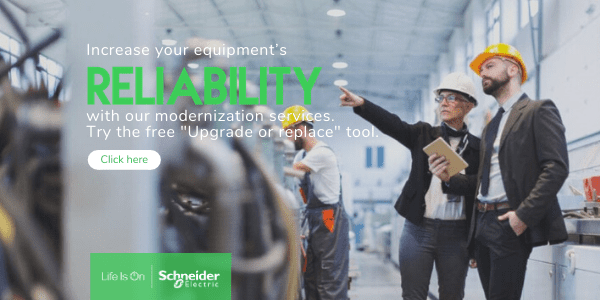Equipment Modernization: Ensuring Safety and Uptime in the Present and Reducing Risk in the Future
Credit to Author: Frederic Abbal| Date: Mon, 10 Feb 2020 09:25:16 +0000
You can probably think of a million reasons to put off that expensive, possibly disruptive equipment upgrade you’ve been planning – even though you know it will be a tremendous improvement in the long term. But the fact is, deferring maintenance and modernization can be a costly proposition. One study conducted by the International Society for Automation put the annual cost of downtime in the manufacturing industry at around $650 billion.
Beyond that sobering figure, here are three good reasons you should consider modernizing now instead of waiting.
Safety
For any forward-thinking executive, there is no time like the present to reduce risk. Addressing a potentially unsafe condition pays benefits both now and in the future. Whether it’s as challenging as an overdue equipment upgrade or as simple as updating a procedure, your investment in keeping your people and equipment safe and secure launches an immediate payback that is likely to continue well into the future.
One way to improve safety in your facility is to take proactive measures to prevent electrical switchgear failure. More likely to happen with older equipment, switchgear failure can cause serious injury to personnel and damage equipment. Following recommended maintenance practices is one important way to keep equipment operating safely. Such regular attention also enables personnel to watch for telltale signs of early deterioration and avoid unanticipated failures by upgrading or replacing older switchgear.
Cost savings
The idea that you must spend money to make money applies to facility and equipment costs as much as any other aspect of a business. Carefully evaluating how you’re going to spend that money is a key element in any successful venture. That can be a difficult task because options are always changing, even as your equipment continues to age. Bear in mind, though, that it’s almost always more economical and cost-effective to attend to system deficiencies before a failure occurs. Sure, the base cost of replacement may be exactly the same, but the costs of dealing with even a less than catastrophic failure can quickly skyrocket.
Another advantage of upgrading your assets is the ability to use the connectivity that is standard in today’s technology. This built-in feature enables an even more careful approach to maintaining and modernization equipment.
Also, in many cases, modernizing existing electrical switchgear, rather than replacing it, can save physical equipment costs as well as time and labor. If you’re thinking of replacing or upgrading your electrical switchgear, try our free online tool to determine which solution is the right one for your operations.
Switchgear lifespan
Modern electrical distribution equipment is designed to be rugged and durable, allowing it to deliver flawless and dependable performance for years. But even the best equipment doesn’t last forever. Most switchgear now in service, for example, has an operational life expectancy of anywhere from 10 to 30 years. At the same time, both industry standards and technology offerings continue to evolve, which means that with every passing year the electrical distribution system installed years ago is moving closer to functional obsolescence. Modernizing your electrical distribution equipment sooner rather than later is an excellent way to ensure a continuing, reliable supply of power throughout your facility.
Success stories from the field
Both large and small firms all around the world are realizing significant benefits by taking advantage of opportunities to modernize their electrical distribution systems. Here are just a few examples.
- New Capabilities Lead to New Efficiencies: A heavy industrial manufacturer in India modernized its dry transformer substation to enhance power availability, meet budget constraints, minimize downtime, and provide continuous monitoring of critical assets. The solution included installing more than a dozen temperature and humidity sensors inside the transformer cubicle and the substation. Temperature sensors were also installed on the transformer connections. Adding these digital features to the existing installation improved operation maintenance while extending equipment life and providing greater reliability.
- A Higher Level of Safety: An automotive manufacturing plant in Mexico modernized numerous aspects of its plant electrical distribution system to ensure worker safety, meet company standards and local codes, improve technical capabilities to deal with unexpected failures, and make up for the lack of expert support from local suppliers. The solution provided by Schneider Electric included management services, engineering, installation, supervision, commissioning, and diagnostics. Additionally, training was adapted to the specific needs of plant personnel.
- Better Performance: A mining company in Morocco wanted to modernize its oil circuit breaker, which was more than 30 years old, to obtain higher breaking current performance. It also wanted to keep the same off-road haul truck fleet. Schneider Electric installed new panels with the appropriate circuit breakers including four trucks and circuit breakers adapted to attain the expected ratings. The solution was both plug-and-play and fully compatible.
Making tough choices
How do you know whether upgrading or replacement is best for your company and when to do it? Those can be a difficult decisions, partly because one firm’s priorities are different from every other. Schneider Electric offers an online tool to help with this decision-making process and timing. By answering a few simple questions about your installation, you’ll have expert guidance in minutes.
Try the free “Upgrade or Replace” online tool.
The post Equipment Modernization: Ensuring Safety and Uptime in the Present and Reducing Risk in the Future appeared first on Schneider Electric Blog.
http://blog.schneider-electric.com/feed/
